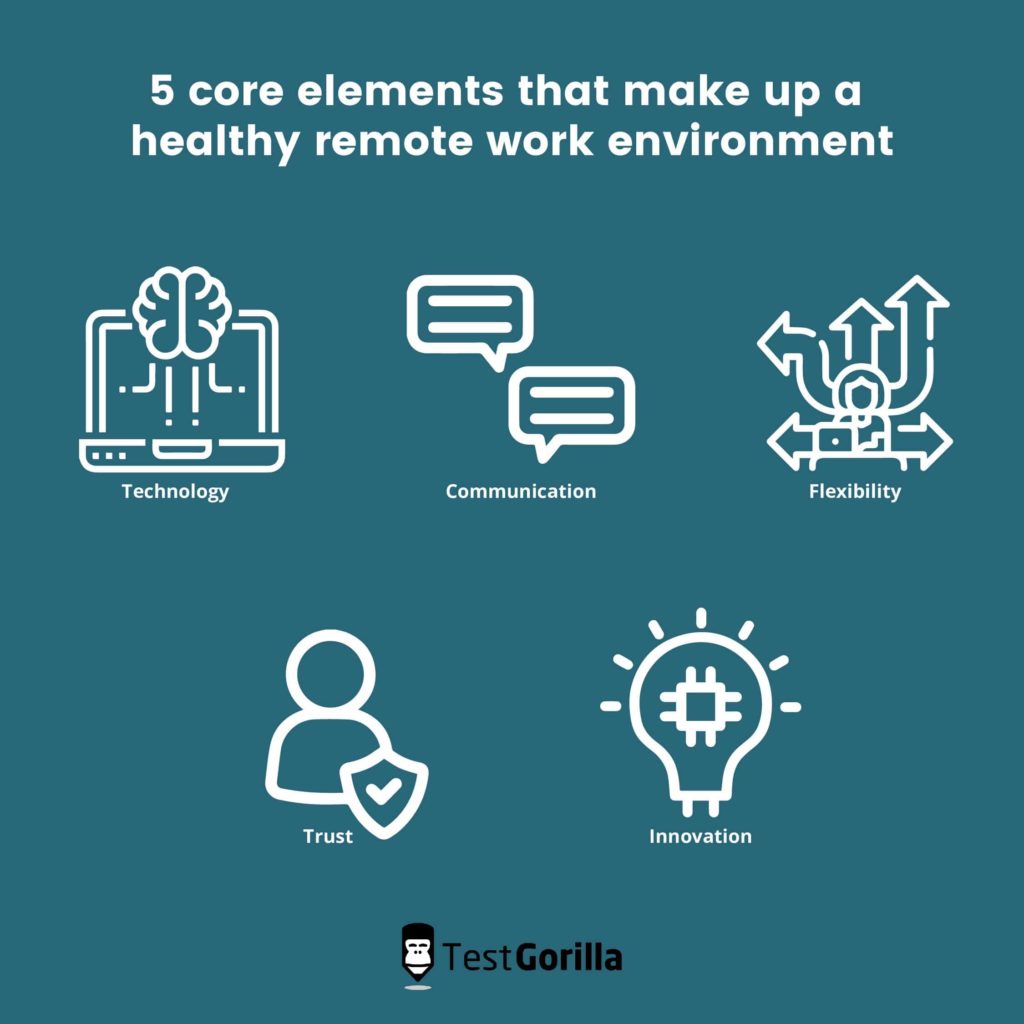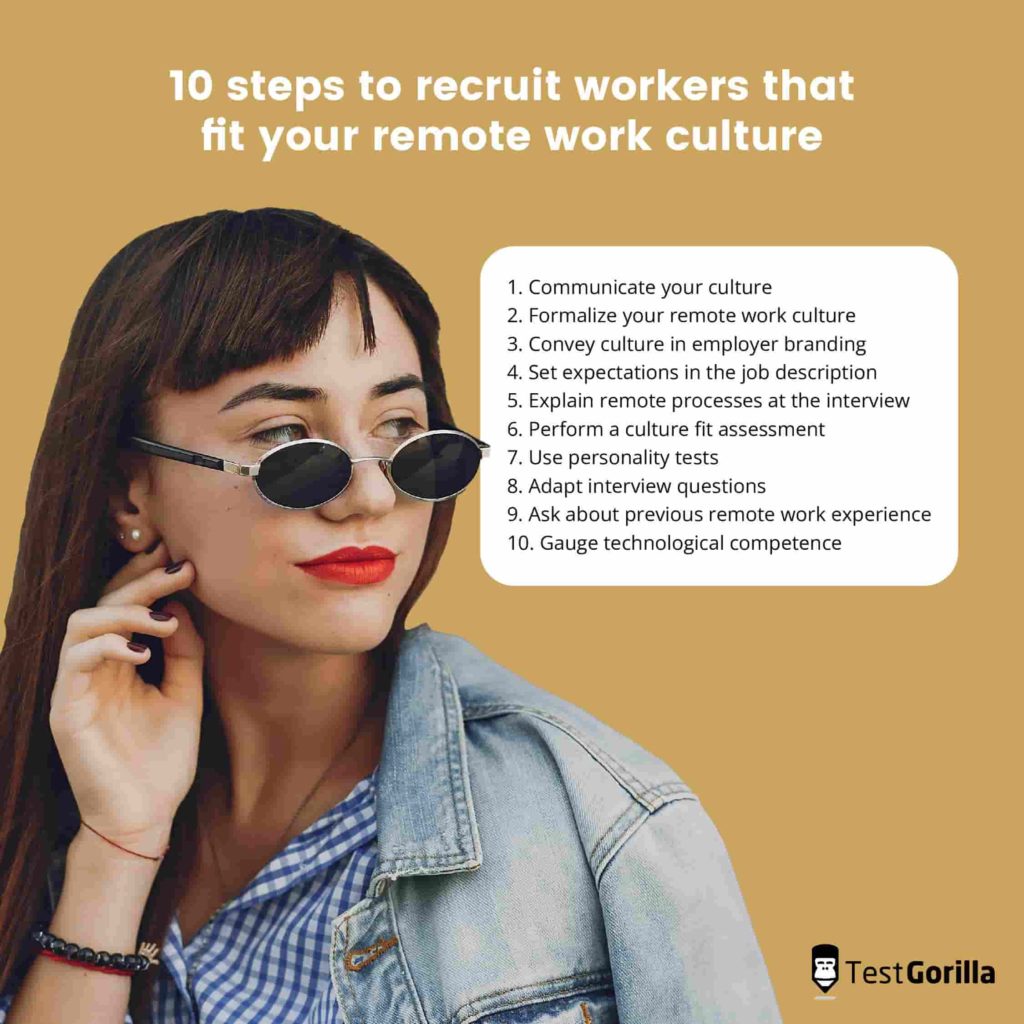Table of contents
Like it or loathe it, remote work is now a dominant arrangement in the workforce. Even as offices reopen in the post-pandemic world, at least 1 in 4 Americans will be working from home.
As more businesses adopt hybrid work models and onboard remote employees, hiring managers are forced to rethink traditional recruitment techniques. Increasingly, they must source talent that not only performs well but is also suited to remote work culture.
But what exactly is remote work culture? And how can you perform an effective cultural fit assessment for remote work candidates?
Below, you’ll find the answers to these questions as well as a host of convenient remote culture fit assessment tips.
What is remote work culture?
Remote work culture is a feeling of shared purpose in remote teams where co-workers are connected by similar goals, values, and interests. The sense of belonging is strong despite the fact that team members are separated by distance and may have never met face to face.
Remote work culture is sustained in a completely different way to office-based work culture. Team leaders have their own set of best remote work practices to keep things running smoothly. Similarly, working from home demands a distinct set of employee skills.
Your unique remote workplace culture should also include elements of your company’s own culture. But across all organizations, five core elements make up a healthy remote work environment. These should be considered during the hiring process when assessing culture fit.
Technology
Remote work is underpinned by technology. From communication platforms like Slack to video meeting software such as Zoom, there is a wide variety of remote work tools that teams rely on to stay connected throughout the working day.
As such, remote employees must be relatively tech-savvy. You can always provide training during the onboarding process, but a basic level of technological competence will allow new team members to integrate well and progress in the role quickly.
Flexibility
Employees working from home are expected to manage their own schedule, making themselves available for meetings and other commitments where necessary.
In many cases, remote work comes with flexible working hours. This can be a mutually beneficial arrangement for staff and their employers; according to Gartner, 43% of remote workers say that flexible working hours allow them to be more productive.
Communication
With employees separated from each other, there’s added emphasis on communication and collaboration within remote teams. Open communication channels should be in place, and expectations need to be set on the regularity of contact between team members.
Some organizations may run daily meetings, while others opt for just one per week. Either way, it’s essential to check that candidates are consistent communicators when assessing culture fit.
Trust
More time spent working independently means remote team members have to trust each other to pull their respective weight. Employers should avoid the temptation to micromanage their staff, as this can damage their output and satisfaction.
Trust is built through regular interactions. For this reason, many organizations arrange virtual “happy hour” socials for remote team-building purposes. Employees should be willing to build these pillars of trust with colleagues and also contribute their own remote work culture ideas.
Innovation
A remote working environment should provide workers with the tools to grow professionally. This includes training programs to develop new skills and opportunities to venture occasionally beyond the boundaries of their day-to-day duties.
Equally, remote workers should be committed to driving innovation in their organization. Team leaders should provide regular feedback and help remote staff understand their part in fulfilling organizational objectives.
10 steps to help you find candidates that fit your remote work culture
It’s no secret that the best organizations have a strong company culture. While building your culture internally is crucial, finding recruits with the right cultural fit is also key.
But how do you assess culture fit for remote roles? The truth is, many hiring managers don’t know how to perform a remote culture fit assessment and often lapse into common remote hiring mistakes.
We’ve put together ten remote culture assessment tips so that you can avoid this fate.
1. Communicate your culture
Hiring managers are responsible for communicating the company’s remote work culture effectively to prospective applicants. This helps attract candidates who’d be a good cultural fit while repelling others who are unsuited to your remote work environment.
From the candidate’s first interaction with your company to the final interview, there are many opportunities to promote your remote work culture.
2. Formalize your remote work culture
The next step is to define your organization’s remote work culture and what constitutes a good cultural add. Take your company’s key values and consider how these can be transmitted to staff working from home.
Here are some helpful questions to get you thinking about your ideal remote work environment:
How should employees feel?
How are staff managed?
How do team members communicate?
Formalize your culture into a written statement that you can use as a reference during remote culture fit assessments.
3. Convey culture in employer branding
Company branding is your first opportunity to capture the interest of suitable candidates. According to LinkedIn, 3 in 4 job-seekers consider employer branding before applying to a role.
Particularly with remote positions, it’s important to perfect your online touchstones as these will likely be the first interaction that prospective applicants have with your organization.
On your company website and social channels, make sure to express the core values of your remote work culture. Promoting your flexible working arrangements or inclusive initiatives, for example, will encourage potential candidates who share the same values to apply.
4. Set expectations in the job description
The job advert is your opportunity to set the expectations of the role. While it is important to promote the perks of the position, always be transparent when describing the job — misleading the applicant will only hurt your organization in the long run by increasing employee turnover.
For instance, be clear that the role is remote and outline how this will work for the applicant if they are successful. Explain their responsibilities as a remote worker as well as what they can expect from their team members.
Besides specific tasks related to the role, you should also include cultural fit requirements in the job description. This gives job-seekers a clearer picture of your remote work environment, allowing them to make a more informed decision about whether to apply.
5. Explain remote processes at the interview
During the interview stage, you should elaborate on the job description to provide the applicant with more information about the remote role.
This is where you can go into more detail about the specifics of the position, such as the provision of equipment, flexible working arrangements, and regularity of team meetings.
You may want to explain some of the remote technologies that your organization uses, such as your virtual workspace, conference call platform, or productivity tracking software.
Where you have applicants with no previous remote work experience, take time to discuss the potential pain points of working from home. The most common ones include:
Loneliness
Managing your workspace
Challenges to work-life balance
If the candidate has an issue with any of these points, they’re unlikely to pass a remote work culture fit assessment.
6. Perform a culture add assessment
Provided that you’ve clearly communicated your remote work culture to candidates throughout the recruitment process, you’ll have done everything you can to attract the right people.
The second stage is to measure each applicant’s suitability with a remote work culture fit assessment. Assessing culture add for remote positions is tricky and requires a different approach to office-based cultural adds. The next steps will help you assess this properly.
7. Use personality tests
It’s extremely difficult to judge a candidate’s cultural fit with your company simply by reading their resume and cover letter. Fortunately, the number of culture fit assessment tools available in the hiring manager’s arsenal is expanding, with personality tests leading the way.
As part of the initial screening process, deploy a culture add test to see how closely the applicant’s values and behaviors align with your company culture. Immediately ruling out the candidates unsuited to your organization will save lots of time and effort.
When combined with a resume, the results of a personality test can be used to identify candidates who are not only technically competent in the role but also culturally sound within your organization.
8. Adapt interview questions
One of the best culture fit assessment tools at your disposal is the interview. If you have doubts about a candidate’s suitability for your organization, this is your opportunity to quiz them about their values and working behaviors.
Come up with a list of incisive interview questions that probe specific remote working skills. These will vary depending on the role, but some general questions include:
Are you a self-starter?
What are your organizational skills like?
How do you like to communicate with team members?
You also need to pry into their working values. Here are some culture fit interview questions for remote positions that you should consider asking candidates:
What is your ideal remote working environment?
What do you value in a remote team?
What excites you about this role?
Map the interviewee’s answers to the culture fit interview questions against your ideal candidate profile to see if there’s a strong match.
9. Ask about previous remote work experience
Besides culture fit interview questions, make sure to ask whether the candidate has prior experience working remotely. Applicants with no previous experience must understand the expectations of remote work.
Ask candidates who have previously worked in a remote role to elaborate on their experience. Listen carefully to how they describe the experience — a useful technique is to ask them the best and worst things about working from home.
Based on the responses, consider how closely their previous remote working experiences align with your organization’s expectations.
10. Gauge technological competence
As mentioned above, technology is an essential element of any remote work environment; assessing a candidate’s competence with specific software should be an important part of your remote culture fit assessment.
Throughout the recruitment process, make an effort to replicate the remote processes used in the role day-to-day, such as email and video conferencing. When assessing culture fit, evaluate how effectively the candidate uses these communication channels.
During the interview, pay attention to how well the candidate expresses themself and presents ideas over a video call. Remote communication is especially key for roles involving regular meetings. If the applicant is confident using these channels, they will likely fit into your remote work environment well.
Hire employees that are a good fit to your remote work culture and unlock your organization’s true potential
Building these steps into your remote hiring process is surprisingly simple and will help your company reach its potential.
We can summarize the benefits of hiring culture fit remote workers as follows:
Boosts productivity. Employees that buy into their company’s culture are more motivated and more productive.
Improves employee experience. Shared values breed engagement and loyalty. They also reduce turnover.
Future-proofs your business. The remote workforce is growing. Establishing a strong remote work culture today will give you an edge tomorrow.
By implementing the culture fit assessment tips outlined above, you can find new hires that will thrive in your organization’s remote work environment and push the company forward.
Related posts
Hire the best candidates with TestGorilla
Create pre-employment assessments in minutes to screen candidates, save time, and hire the best talent.
Latest posts
The best advice in pre-employment testing, in your inbox.
No spam. Unsubscribe at any time.

Hire the best. No bias. No stress.
Our screening tests identify the best candidates and make your hiring decisions faster, easier, and bias-free.
Free resources
This checklist covers key features you should look for when choosing a skills testing platform
This resource will help you develop an onboarding checklist for new hires.
How to assess your candidates' attention to detail.
Learn how to get human resources certified through HRCI or SHRM.
Learn how you can improve the level of talent at your company.
Learn how CapitalT reduced hiring bias with online skills assessments.
Learn how to make the resume process more efficient and more effective.
Improve your hiring strategy with these 7 critical recruitment metrics.
Learn how Sukhi decreased time spent reviewing resumes by 83%!
Hire more efficiently with these hacks that 99% of recruiters aren't using.
Make a business case for diversity and inclusion initiatives with this data.





















